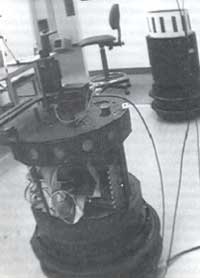Every breath you take
 You cannot shake them off. They are better, More effective than bloodhounds and they will be watching every move you make. Researchers in California, USA, have developed Autonomous Observer (AO), a robot that could lead to advanced surveillance systems that follow people wherever they go. Continuous surveillance is not a new concept. Author George Orwell toyed with the idea in his landmark book 1984 which describes a political dystopia where the enigmatic 'Big Brother'watches everyone. AO Seems like a high-tech) 21st century extension of Orwell's'Big B'.
You cannot shake them off. They are better, More effective than bloodhounds and they will be watching every move you make. Researchers in California, USA, have developed Autonomous Observer (AO), a robot that could lead to advanced surveillance systems that follow people wherever they go. Continuous surveillance is not a new concept. Author George Orwell toyed with the idea in his landmark book 1984 which describes a political dystopia where the enigmatic 'Big Brother'watches everyone. AO Seems like a high-tech) 21st century extension of Orwell's'Big B'.
Most existing surveillance systems cannot track targets that arc trying to avoid detection. And once the target disappears from view, the tracking systems lose it. But A0 is smarter. Developed by Stanford University's computer scientist Jean-Claude Latombe, AO is actually a'team' of small mobile robots that not only follow objects, but can also work out their potential escape routes and place themselves for optimum view.
Following people around may seem easy enough for humans, but as far as robots are concerned, it is a whole new story, not to mention a huge challenge. To work properly, the mobile AO units must 'understand' exactly what is around them. To work out where objects are, each AO unit uses a laser rangefinder to add depth to images captured by its video camera. That way a three-dimensional (3D) of its environment is created which can be used later as reference while the A0 robot follows its target (Science, Vol 282, No 2156).
As an Ao tracks its target, it uses this 3D model to look for the structure that the target is most likely to hide behind, such as a wall or a corner. The AO unit then positions itself in a way as to give its camera the widest possible field of view, making it very hard for the target to hide or escape. As the AO's 3D maps are updated four times every second, human as well as robot targets found it very hard to escape detection in tests.
As of now, the AO'S surveillance capabilities are limited to the laboratory. Though the units are currently navigating with the help of a rather complex grid system, Latombe says they will because fitted with global positioning system (GPS) to enable them to work outside.
It is pretty easy to guess where these Ao units will be employed. They could work as factory supervisors, overseeing factory robots and reporting breakdowns. And they could most certainly be working for the defence setvices in the future. Latombe is already being funded by the us Defense Advanced Research Projects Agency who seem very interested in AO'S Military capabilities. "Robots could be used as scouts to hunt down enemy soldiers in hiding in buildings before the troops move in," Latombe speculates.
Companies could use Latombe's tracking systems to improve their closed-circuit security systems. "If you have too many cameras, the problem is knowing which one to look at," says Latombe. With these snooper AOS in control, security systems might be able to track intruders as they move through a building, automatically switching from one camera to the next.
Related Content
- The 2023 climate risk landscape
- Synergizing action on the environment and climate: good practice in China and around the globe
- National Clean Air Programme (NCAP)
- Two Indians die every minute due to air pollution: Study
- Clear the air for children: the impact of air pollution on children
- The economic consequences of outdoor air pollution
